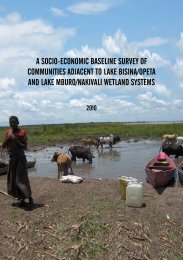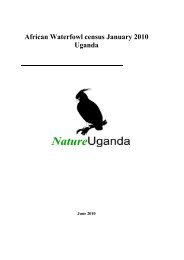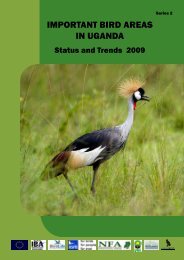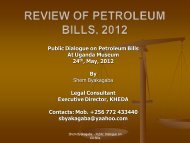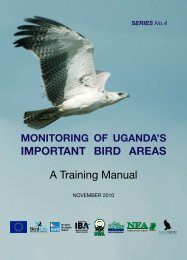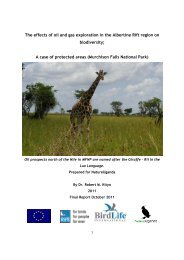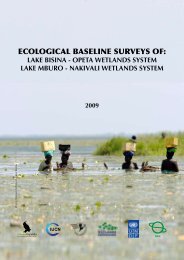the economic valuation of the proposed ... - Nature Uganda
the economic valuation of the proposed ... - Nature Uganda
the economic valuation of the proposed ... - Nature Uganda
You also want an ePaper? Increase the reach of your titles
YUMPU automatically turns print PDFs into web optimized ePapers that Google loves.
The basis to estimating <strong>the</strong> annual value <strong>of</strong> ecotourism<br />
is <strong>the</strong> consumer surplus, <strong>the</strong> difference between <strong>the</strong><br />
price tourists are willing to pay and <strong>the</strong> price <strong>the</strong>y<br />
actually paid. Naidoo & Adamowicz (2005) found that<br />
an entrance <strong>of</strong> US$47 would maximise tourism value<br />
compared to <strong>the</strong> amount foreign and foreign residents<br />
<strong>of</strong> <strong>Uganda</strong> are currently charged (US$5) to visit Mabira<br />
CFR (Naidoo & Adamowicz 2005). This dramatic under-<br />
<strong>valuation</strong> <strong>of</strong> <strong>the</strong> willingness to pay <strong>of</strong> tourist visitors is<br />
consistent with results from o<strong>the</strong>r tropical areas and<br />
suggests much room for improvement in entrance fee<br />
policy (Naidoo & Adamowicz 2005).<br />
From <strong>the</strong> above, <strong>the</strong> consumer surplus for foreigners<br />
and foreign residents is US$42 per tourist. In <strong>the</strong> absence<br />
<strong>of</strong> data on <strong>the</strong> local tourists’ willingness-to-pay and<br />
considering <strong>the</strong>ir low income levels, this study assumes<br />
a zero consumer surplus pertaining to local tourists. For<br />
foreigners and foreign residents US$ 42 or UShs 71,400<br />
(at exchange rate <strong>of</strong> UShs 1700 to <strong>the</strong> US$) – was used.<br />
Fur<strong>the</strong>rmore, using <strong>the</strong> 2005/06 data for foreigners and<br />
foreign residents <strong>of</strong> 1,989 tourists, <strong>the</strong> annual value <strong>of</strong><br />
ecotourism for <strong>the</strong> whole Mabira CFR was estimated<br />
at UShs 142,014,600/year. Mabira CFR is about 30,000<br />
ha in size and it would be incorrect to allocate all <strong>the</strong><br />
annual value lost due to <strong>the</strong> impact area <strong>of</strong> 7186 ha.<br />
Hence, <strong>the</strong> proportionate share <strong>of</strong> ecotourism benefits<br />
lost was estimated as a fraction <strong>of</strong> <strong>the</strong> value for Mabira<br />
as a whole (that is, UShs 142,014,600/year x 7186/30000)<br />
giving a value <strong>of</strong> UShs 34,083,504/year. Subsequently<br />
<strong>the</strong> present value <strong>of</strong> <strong>the</strong> ecotourism benefits foregone<br />
translates into Ushs 284,029,200 (or US$167,076).<br />
This estimate must be considered a very conservative<br />
one and demonstrates <strong>the</strong> room available for ecotourism<br />
to grow in Mabira CFR. It is quite possible that once <strong>the</strong><br />
planned and <strong>the</strong> on-going ecotourism development<br />
projects are completed <strong>the</strong>re will be a dramatic increase<br />
in tourist numbers and <strong>Uganda</strong>n tourists will also begin<br />
to register significant consumer’s surpluses. These<br />
developments are likely, <strong>the</strong>refore, to propel <strong>the</strong> annual<br />
value <strong>of</strong> ecotourism closer to <strong>the</strong> $360/ha mark which<br />
was registered in Madagascar.<br />
F. CARBON STORAGE AND SEQUESTRATION<br />
When a forest is under threat <strong>of</strong> conversion, it is important<br />
to distinguish two values. The first is <strong>the</strong> value <strong>of</strong> <strong>the</strong><br />
carbon stored in a standing forest that is close to ‘carbon<br />
balance’. The second is <strong>the</strong> value <strong>of</strong> carbon sequestered<br />
in a growing forest. In o<strong>the</strong>r words <strong>the</strong> carbon storage<br />
value is <strong>the</strong> value held in <strong>the</strong> growing stock or standing<br />
timber volume. The sequestration value is <strong>the</strong> value <strong>of</strong><br />
<strong>the</strong> amount <strong>of</strong> additional carbon absorbed by <strong>the</strong> forest<br />
as it adds more volume annually.<br />
Brown and Pearce (1994) provide some benchmark<br />
figures for carbon content and loss for tropical forest<br />
conversion situations (Table 21). A closed primary forest<br />
has 283tC/ha <strong>of</strong> carbon and if converted to permanent<br />
agriculture would release 220tC/ha (283tC/ha less 63tC/<br />
The Economic Valuation <strong>of</strong> <strong>the</strong> Proposed Degazettement <strong>of</strong> Mabira CFR | 2011 43<br />
ha).<br />
Table 20: Carbon content and loss for tropical forest conversion<br />
Forest type<br />
Forest Original<br />
Carbon (tC/ha)<br />
Permanent Agriculture<br />
Carbon (tC/ha)<br />
Closed primary forest 283 /a 63 /c -220<br />
Closed secondary forest 194 /b 63 -131<br />
Open forest 115 63 -52<br />
/ a – 116 soil, 167 biomass; / b – 84 soil, 110 biomass; / c – mainly soil<br />
Source: Brown and Pearce (1994)<br />
Quantity <strong>of</strong> Carbon Released by<br />
conversion (tC/ha)<br />
For closed secondary and open forests, <strong>the</strong> corresponding figures are 131tC/ha and 52tC/ha, respectively. A large



